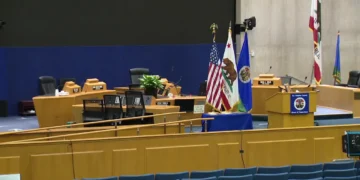Between battleground Congressional seats and key statewide propositions—like raising the minimum wage and altering taxpayer protections—L.A. voters have much to consider this cycle.
The weather is starting to cool, and students are returning to school, which means we’re heading into election season in America. But voting can be overwhelming, with countless candidates, ballot measures, and more to get versed on before November 5th. That’s why we’ve developed this go-to guide for all things voting in Los Angeles County.
Where to start? Before you fill out your ballot, you need to have access to one. You should have received a vote-by-mail ballot if you are a registered voter. You can fill it out ahead of time, mail it in postmarked on or before Election Day to be counted by Nov. 12th, drop it off at a secure drop-box location, or bring it to a voting center on Election Day.
Ballot drop-off locations opened on October 8th, and you can use this handy tool by the L.A. County Registrar-Recorder to find the location nearest to you. Anyone interested in in-person voting should know that vote centers open for early voting on October 26th. On November 5th, polls will be open from 7:00 AM to 8:00 PM PST.
If you’re not a registered voter, the last day to register is October 21st, so plan accordingly. Registering to vote can be done with ease on the official California Secretary of State (SOS) website, where they guide you through the process, help you find your local polling place, and get answers to frequently asked questions. Not sure if you’re registered to vote or which political party you registered for? They’ve got a service for that, too.
With all this in mind, it’s time to tackle the meat and potatoes. This cycle, L.A. County hosts several closely-watched races.
Did you know that the L.A. County District Attorney’s Office is the largest prosecuting agency in the country? This fall, criminal defense attorney Nathan Hochman challenges incumbent progressive prosecutor George Gacsón for the chance to be L.A. County’s District Attorney.
Another hot topic in L.A. County is Measure G, which would expand the L.A. County Board of Supervisors. Presently, each of the five supervisors has a constituency of around two million people. If Measure G passes, the board would add four more supervisors, bringing the total to nine and reducing the amount of constituents for each.
Additionally, Measure G would change the county CEO from an appointed position to an elected one. While supporters of Measure G think this could improve representation and accountability, opponents point out that it would likely lead to additional taxpayer burden and politicize the CEO position.
L.A. voters also have the opportunity to impact critical U.S. House of Representative races –– potentially reshaping the power balance in D.C. One particularly competitive election is for California’s Congressional District 27, where Democrat candidate George Whitesides is challenging incumbent Republican Mike Garcia.
Whitesides, former CEO of Virgin Galactic and NASA chief of staff under Obama’s administration, seeks a seat representing northern Los Angeles County cities such as Santa Clarita, Lancaster, Palmdale, and more. Representative Garcia won this district after a 2020 special election caused by Democrat Katie Hill’s sex scandal and was re-elected in 2022 by only six percentage points.
Insiders are also watching several state legislature races, like California’s 23rd Senate District. Former Assemblywoman Suzette Valladares, a moderate Republican, is challenged by local attorney Michael Mueller. Though Mueller is running as a moderate Democrat and touts experience as a former criminal prosecutor, critics allege he padded his resume.
Another can’t-miss race is California’s 42nd Assembly District, where Democrat incumbent Jacqui Irwin faces a new challenger: Republican businessman Ted Nordblum. The recently redrawn district hits areas of L.A. County like Bel Air, Malibu, and Pacific Palisades. Irwin enjoys the privilege of being an incumbent, but Nordblum and the Republicans have an ever-so-slight voter registration advantage.
There are also many statewide propositions voters can oppose or support. Proposition 5 has gained public interest as it would attack existing Prop. 13 taxpayer protections. Its critics argue that California taxpayers already pay a hefty burden, and Prop. 5 could make it even tougher for middle and low-income families to remain in the Sunshine State.
Other key propositions to watch include Proposition 32, which would advance a state minimum wage increase to $18 per hour by 2026––undoubtedly a hindrance for many small business owners––and Proposition 33, which could further drive up housing costs by allowing rent control on privately owned single-family homes.
Finally, after you’ve voted, don’t forget to track your ballot using California’s Ballottrax service, also known as Where’s My Ballot.
As America is a representative democracy, it’s our unique privilege to have the right to vote for our government officials and ballot measures. Sometimes, elections are decided upon by very slim margins, so no matter how much you may feel like a small fish in a big pond in California, don’t let anyone convince you otherwise: your vote matters!


























